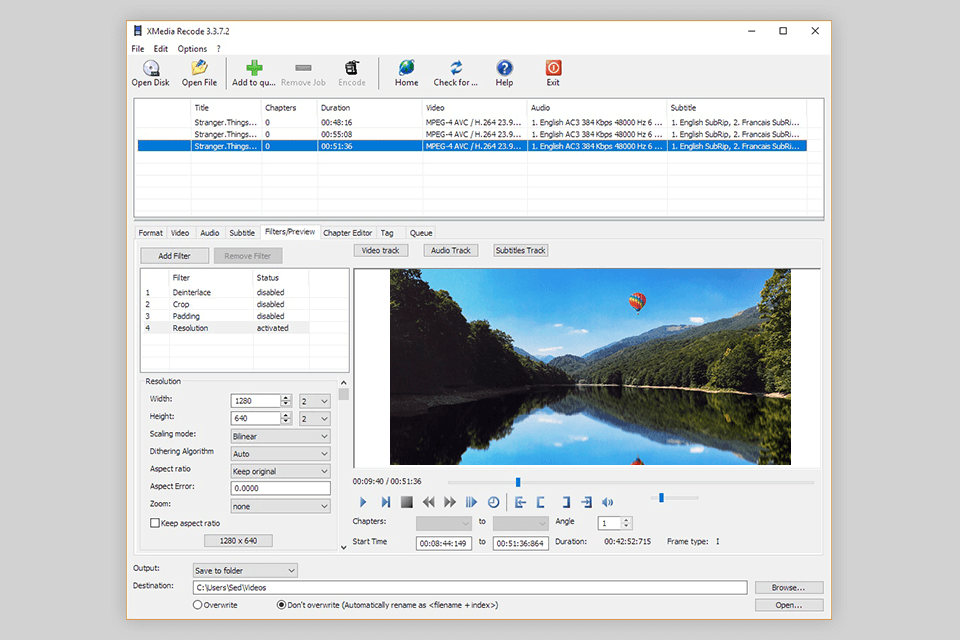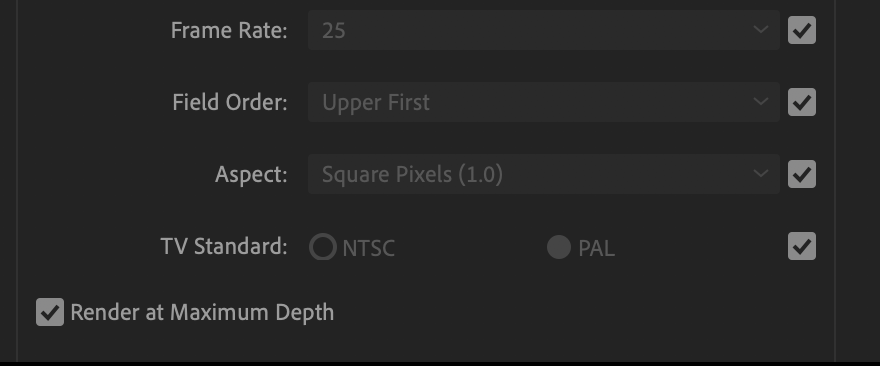Deinterlace Footage Adobe Media Encoder Cc
See Alpha channel support in Adobe Media Encoder CS4. Tick 'Deinterlace Video Footage’. Community content is available under CC-BY-SA unless otherwise noted. Today we’re extremely excited to be releasing the very latest versions of Premiere Pro CC and Adobe Media Encoder CC, which are accompanied by brand new releases of After Effects, Character Animator, Audition, and many other Adobe Creative Cloud applications. Using a free 7-day trial of Premier Pro and Adobe Media Encoder I was able to deinterlace and transcode the.mts files to pro res, but I have a lot of.mts footage and was hoping to avoid Adobe's subscription pricing. Are you aware of an issue with QTGMC and.mts files?
- Deinterlace Footage Adobe Media Encoder Cc 2017
- Deinterlace Media Encoder
- Deinterlace Footage Adobe Media Encoder Cc
- Deinterlace Footage Adobe Media Encoder Cc

Today we’re extremely excited to be releasing the very latest versions of Premiere Pro CC and Adobe Media Encoder CC, which are accompanied by brand new releases of After Effects, Character Animator, Audition, and many other Adobe Creative Cloud applications.
Deinterlace Footage Adobe Media Encoder Cc 2017
Creative Cloud members and trial users will be able to download and install these applications today using the Creative Cloud desktop application, or online from http://www.adobe.com/creativecloud.html.
Please note that the newly released versions of Adobe Creative Cloud applications will overwrite prior installations by default. This behavior can be changed in the Creative Cloud desktop app. Also, please be aware that projects saved in Premiere Pro 2017.0 cannot be opened with previous versions.
These releases contain all of the features revealed at IBC 2016, including powerful new hosted collaboration technology with Team Projects, improved support for the creation and editing of open and closed captions, enhanced color workflows with improved color pickers in the Lumetri Color Panel and support for HDR10, significant improvements to VR workflows including auto-detection, Destination Publishing to Behance, refined Live Text Templates, new visual keyboard shortcut mapping, clip stitching in Adobe Media Encoder, and so much more. And be sure to get the scoop on the Social Publishing panel (Beta) for Premiere Pro.
Other new features included in these releases are listed below:
- A new Global FX Mute button in the Program Monitor to temporarily disable all non-intrinsic effects in a sequence
- DNxHD export into a QuickTime .mov wrapper on Windows without Apple QuickTime being installed
- Several new audio effects: Adaptive Noise Reduction, Dynamics Processing, Parametric Equalizer, Automatic Click Remover, and Studio Reverb
- Multiple user interface enhancements
- Improvements to XAVC 60p playback performance
- Support for RED Helium
- Improvements to Apple Metal, including support for Lumetri
- Ability to create sequence presets from an already created sequence
- A new Save button in the Keyboard Shortcuts window
- New Title Styles presets
- GPU accelerated Offset and Lens Distortion effects
- Option to export MXF file with 12 audio channels
- New Project Locking preference to allow the displaying in the Media Browser of the username of the user who has the project open (locked) , and preventing a project from being opened by more than one user at a time
- Multi-cam settings are respected in FCP XML import
- Alpha-only export from an After Effects composition in Adobe Media Encoder
- New ‘Multi-Camera Selection Top Down’ item in Timeline wing menu to enable top-most targeted track’s multi-cam to show when in multi-cam mode (default behavior is lowest)
- Composite shown when in multi-cam mode when a clip is not multi-cam
These releases also contain several hundred bug fixes and improvements; a list of notable ones appears below.
Premiere Pro
—Proxy—
- Ingest Copy could only copy reference file, which results in an offline clip and proxy failure
- Create Multi-Cam Sequence command could initiate an ingest process
- Search was not working reliably for proxy media
- Interpret Footage changes were sometimes not correctly applied to Proxy and/or Hi-Res media
- Speed/Duration, via Clip options, was disabled for clips with offline full res, but online proxy
- Paste and duplicate in Project panel could initiate an ingest process
–Import—
- MXF media with non ASCII AS-11 metadata could lead to a crash on import
- Premiere Pro could crash when turning layers on and off in dynamically linked After Effects composition
- Importer errors / async timeouts for MPEG MOV files have been resolved
- Certain ProRes .mov files imported as audio-only, without video
- Some QuickTimes files were imported as Audio only file on a machine which does not have QT installed

—Audio—


- Audio channel bleed and intermittent distortion was sometimes encountered when track panning a stereo clip that had been remapped to be 2 stereo clips
- Memory allocations were being ignored when conforming audio files and this could cause a crash
- Flattening a switch audio multi-cam clip that had audio effects applied to the source audio could cause a crash
- QuickTime growing files waveforms were sometimes constantly regenerated and never saved
- Situations where audio missing warnings appeared in console and audio drop-outs were heard have been resolved
- Certain cases where creating proxies would transcode to wrong number of audio channels and will auto-attach the proxy file have been resolved
- Razor cutting the audio inside a multi-cam source sequence could cause the waveforms of the nested multicam clip to display incorrectly and partially disappear
- Audio would sometimes be missing when rendering at 50% after rendering In to Out
- Convergent Design Odyssey ProRes clips could have distorted audio.
- No audio was sometimes heard on playback after applying Maintain Audio Pitch with a Speed change
- At low audio card buffer settings, Playing across silent (and scrubbing) areas of audio could cause noise
- Repeated audio could play instead of correct audio when using “Maintain Audio Pitch” in Speed/Duration dialog

— Playback/Rendering —
Deinterlace Media Encoder
- Occasional stuttered playback and freezes could occur in SDI Transmit image in 720p 59.95 playback with scaled image composited
- Render issues with masks/blur were sometimes encountered when using ProRes as preview files
- Poor playback performance could occur with PQ encoded RGB 444 12 bit J2K MXF
- Artifacts were sometimes rendered when using the “Blacks” control to adjust black areas on HEVC (H.265) media
- GPU accelerated playback of H264 media on Window was slower than software only in some cases
- Waveforms were sometimes drawn scrambled in MXF growing files.****
— Miscellaneous—
Deinterlace Footage Adobe Media Encoder Cc
- Using control surfaces to control Lumetri color wheels could freeze Premiere Pro UI entirely
- Placing a Red Giant Magic Bullet effect on a clip within the timeline sometimes caused a crash
- Situations where it was not possible to get out of full screen mode in Source and Program monitors after playback have been resolved
Deinterlace Footage Adobe Media Encoder Cc
Adobe Media Encoder
- Win7 only: After some operations, AME could crash on quit
- Crashes could occur when exporting projects containing multi-cam
- Ingest Copy could only copy reference file, which results in an offline clip and proxy failure
- Export via QuickTime could fail if exporting with the Animation codec and an audio codec other than uncompressed, giving a “compressor format error”
- Native interlaced DNxHD .mov exports sometimes imported into Avid Media Composer 8 with no video image
- QuickTime native codecs sometimes failed to don’t smart render PAL sources with non-square pixel aspect ratios
- Changes made to After Effects comps inside a Premiere Pro project sometimes weren’t reflected in an export queued to Adobe Media Encoder
- Smart render of AVC-LongG material from a Panasonic camera sometimes failed, with a bitrate mismatch
- MPEG-4/H.264 proxy presets would sometimes increase the frame size, rather than decrease it, for unsupported interlaced frame sizes
- Clips inside Premiere Pro projects viewed in the Media Browser would sometimes incorrectly import as sequences
- Match Source for Batch Export could result in mismatched video codecs, rather than giving a compatibility warning
- QuickTime audio files .mov audio exports always had a 29.97 non-drop timecode even if the originating sequence was not in this frame rate
- Exported AVCi MXF media sometimes had incorrect DisplayWidth and StoredWidth metadata